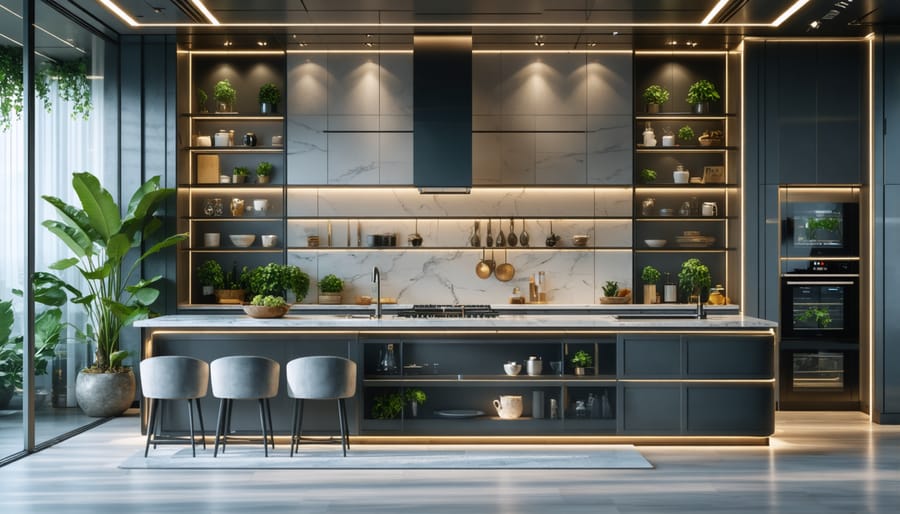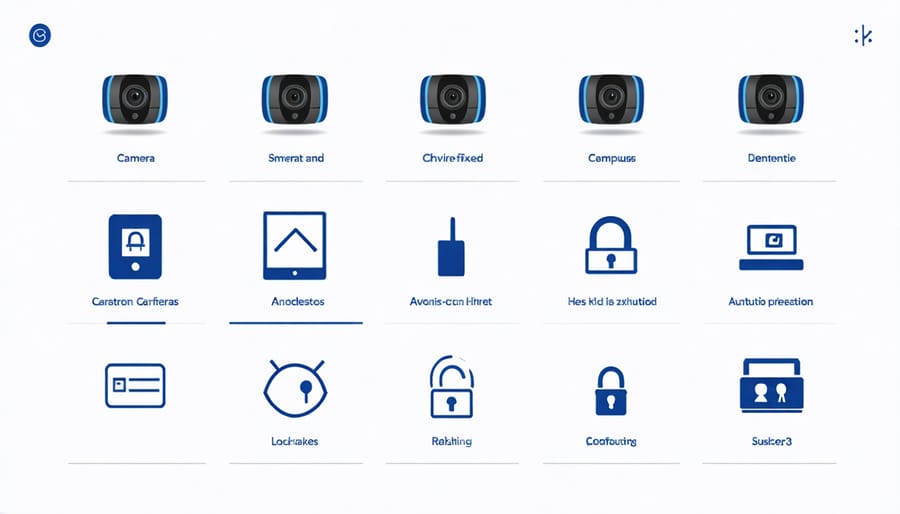Transform your living space into an intelligent sanctuary by designing a comprehensive smart home system that seamlessly integrates automation, security, and comfort. Modern smart home design plans now extend far beyond basic voice commands and automated lighting – they create intuitive environments that anticipate needs, optimize energy usage, and enhance daily living through sophisticated yet user-friendly technology.
Start with a central hub that coordinates your home’s core systems – climate control, security, entertainment, and lighting. Map out zones for specific activities, from a media room with automated blinds and ambient lighting to a kitchen equipped with smart appliances and voice-activated recipe displays. Consider how different spaces flow together and where technology should be visible versus discreetly hidden.
The key to successful smart home implementation lies in thoughtful planning that balances cutting-edge functionality with elegant design. Every element, from hidden speakers to motorized window treatments, should complement your home’s aesthetic while delivering practical benefits. Focus on creating intuitive interfaces that family members of all ages can easily master, ensuring your smart home enhances rather than complicates daily life.
By approaching smart home design as a holistic project rather than a collection of gadgets, you’ll create a living environment that’s both sophisticated and practical – one that truly transforms how you interact with your home while increasing its value and efficiency for years to come.
The Foundation of Luxury Smart Home Design

Smart Home Hub Selection
Selecting the right smart home hub is crucial for successful smart home systems integration, as it serves as the brain of your connected home. When choosing your hub, consider three key factors: compatibility with your existing devices, ease of use, and future expansion possibilities.
Popular options like Samsung SmartThings, Apple HomeKit, and Amazon Alexa offer different strengths. SmartThings excels in device compatibility, HomeKit prioritizes security, and Alexa shines in voice control. Consider which ecosystem most of your current devices belong to – this can help narrow down your choices and ensure smoother integration.
Look for hubs that support multiple communication protocols like Zigbee, Z-Wave, and Wi-Fi. This flexibility allows you to incorporate various devices regardless of their connection type. Also, check if the hub offers local processing capabilities, which can keep your system running even if internet connectivity fails.
User-friendly mobile apps and intuitive interfaces are essential for daily use. Test the app’s interface before committing, as you’ll interact with it frequently. Additionally, consider whether you want voice control capabilities and if your chosen hub integrates well with your preferred voice assistant.
Remember to factor in your home’s size and layout. Some hubs may require signal extenders for larger homes, while others offer better range out of the box. Choose a hub that can comfortably support your current needs while allowing room for future expansions.
Network Infrastructure Planning
A robust network infrastructure is the backbone of any smart home system. Start with a high-speed internet connection of at least 100 Mbps, which provides enough bandwidth for multiple smart devices to operate smoothly. Consider installing a mesh Wi-Fi system to ensure consistent coverage throughout your home, eliminating dead zones that could affect device performance.
Plan your network with future expansion in mind. Install ethernet cables to key locations during construction or renovation – this includes spots for security cameras, smart TVs, and home office equipment. Hardwired connections are more reliable and secure than wireless ones, and they free up Wi-Fi bandwidth for mobile devices.
Create separate networks (VLANs) for your smart home devices and personal devices. This enhances security and prevents smart home traffic from competing with your regular internet usage. Consider installing a dedicated network cabinet or closet to house your router, switches, and smart home hub in a ventilated, accessible space.
Don’t forget about backup power! Install an uninterruptible power supply (UPS) for critical network equipment to maintain functionality during power outages. Also, document your network setup, including device locations, passwords, and configuration details – this will be invaluable for troubleshooting and future upgrades.
Pro tip: Work with a qualified electrician to ensure proper power distribution and cable management for your network infrastructure. This investment in planning will pay off with a more reliable and future-proof smart home system.
Sophisticated Living Spaces

Automated Lighting Design
Creating the perfect ambiance in your smart home starts with thoughtful automated lighting design. Modern lighting control systems offer unprecedented flexibility in crafting the perfect atmosphere for every moment of your day.
Start by mapping out your daily routines and identifying key activities in each space. For example, your kitchen might benefit from bright task lighting during meal prep, while softer, warmer lights create an inviting dining atmosphere. In living areas, consider installing tunable LED fixtures that adjust their color temperature throughout the day – cooler whites for productive mornings, and warmer tones for relaxing evenings.
Motion sensors in hallways and bathrooms can trigger gentle nighttime illumination, while smart switches learn your patterns to automatically adjust brightness based on time and occupancy. Don’t forget about outdoor spaces – pathway lights can activate at sunset and dim late at night for security and energy efficiency.
Create personalized scenes for different occasions: “Movie Night” could dim the living room lights to 20% while keeping subtle accent lighting, while “Welcome Home” gradually brightens your entrance and kitchen as you approach. Most systems now integrate seamlessly with voice assistants and smartphone apps, making it easy to adjust your lighting with simple commands or taps.
Remember to include backup manual controls and consider installing a battery backup system for essential lighting circuits. This ensures your home stays functional even during power interruptions.
Climate Control Zones
Gone are the days of one-temperature-fits-all heating and cooling. Modern smart homes excel at creating personalized comfort zones throughout your living space, making every room perfectly comfortable for its specific use and occupants.
The heart of climate control zoning lies in smart thermostats that can manage multiple zones independently. Each bedroom can maintain its ideal temperature for sleeping, while your home office stays cooler during work hours. The kitchen, which naturally generates heat during cooking, can be adjusted automatically to compensate for the extra warmth.
Installing smart vents in each room allows for precise airflow control, while temperature sensors provide real-time feedback to your system. You can program different schedules for each zone – imagine your master bathroom warming up just before your morning shower, or the guest room cooling down when visitors arrive.
Energy efficiency is a major benefit of zoned climate control. Instead of heating or cooling your entire home to one temperature, you can reduce energy usage in rarely used spaces while maintaining comfort in high-traffic areas. Many systems also learn from your preferences and daily routines, automatically adjusting to optimize both comfort and energy savings.
For the best results, consider combining your climate zones with smart window treatments and ceiling fans, creating a comprehensive approach to temperature management that works seamlessly with your lifestyle.
Entertainment System Integration
Transform your home into an immersive entertainment hub with a well-planned multi-room audio and video system. Start by mapping out your entertainment zones – typically including the living room, bedroom, home office, and outdoor spaces. Consider installing in-ceiling or in-wall speakers for a clean, minimalist look that doesn’t compromise on sound quality.
For seamless integration, opt for smart TVs and soundbars that support popular streaming platforms and voice control. Many modern systems allow you to start a movie in the living room and continue watching in the bedroom without missing a beat. Create different audio zones that let you play different music in various rooms or sync them all together for house-wide entertainment during parties.
Don’t forget about your outdoor spaces – weather-resistant speakers can extend your entertainment system to the patio or garden. For movie enthusiasts, consider a dedicated media room with automated lighting scenes that adjust perfectly for viewing.
Cable management is crucial for a polished look. Plan your wiring routes during the initial design phase, utilizing wall cavities and dedicated conduits. Many homeowners are now choosing wireless solutions where possible, though some hard-wired connections are still recommended for optimal performance.
For convenient control, integrate everything into a single smart home app. This allows you to manage your entire entertainment system, adjust volume levels, and switch inputs from anywhere in your home using just your smartphone or tablet.
Smart Kitchen and Dining

Connected Appliance Ecosystem
Modern smart homes are revolutionizing how we interact with our kitchen appliances through sophisticated smart kitchen automation systems. Imagine your refrigerator automatically creating shopping lists, your coffee maker brewing your morning cup just as you wake up, and your oven preheating itself based on your dinner schedule.
Start by selecting appliances that can communicate with each other through a central hub. Look for devices that support popular protocols like WiFi, Zigbee, or Z-Wave to ensure seamless integration. Smart refrigerators with internal cameras let you check contents remotely, while connected ovens allow you to monitor and adjust cooking settings from your phone.
Consider incorporating a smart dishwasher that can automatically order detergent when supplies run low, and a connected microwave that can download cooking instructions for perfect results every time. Voice-controlled faucets and instant hot water dispensers add both convenience and luxury to your kitchen workspace.
For optimal performance, ensure your home’s WiFi network can handle multiple connected devices. Install a mesh network system if needed, and consider dedicated circuits for power-hungry smart appliances. Remember to regularly update your devices’ firmware to maintain security and functionality.
Keep your ecosystem within one or two compatible brands when possible – this reduces potential connectivity issues and simplifies control through a single app.
Automated Dining Ambiance
Transform your dining experience with smart lighting and environmental controls that create the perfect atmosphere for any occasion. Imagine dimming the lights to a warm, intimate glow for a romantic dinner, or brightening them for a lively family gathering – all with a simple voice command or tap on your smartphone.
Start by installing smart LED bulbs in your dining room fixtures, choosing options that offer both white and colored lighting. These can be programmed to adjust automatically based on the time of day or specific dining scenarios you create. For example, set “Dinner Party Mode” to activate soft amber lighting, or “Breakfast Time” for energizing bright white light that mimics natural daylight.
Consider adding motion sensors that automatically illuminate the space when someone enters, and smart window treatments that adjust based on natural light levels. This combination ensures optimal lighting conditions while helping to reduce energy consumption.
Take your dining ambiance further with integrated climate control. Smart thermostats and connected air purifiers can maintain the ideal temperature and air quality while you dine. Add a smart speaker system for background music that automatically adjusts its volume based on conversation levels.
For the finishing touch, install under-cabinet or architectural lighting that can be zoned and controlled separately. This layered lighting approach allows you to highlight design features while creating the perfect mood for any dining occasion.
Private Spaces and Security
Bedroom Automation
Transform your bedroom into a personal sanctuary with thoughtfully integrated smart features that enhance both comfort and convenience. Start with smart lighting that adapts to your daily routine – program gentle wake-up lights that gradually brighten in the morning and dim in the evening to support your natural sleep cycle.
Install motorized blinds or curtains that can be scheduled to open and close based on sunrise and sunset, or controlled with a simple voice command when you want to sleep in. A smart thermostat with zoned temperature control ensures your bedroom maintains the perfect temperature for restful sleep, automatically adjusting throughout the night.
Consider a smart mattress or sleep tracking device that monitors your sleep patterns and provides insights to improve your rest quality. Voice-controlled bedside lamps and smart plugs eliminate the need to fumble for switches in the dark, while motion-activated under-bed lighting provides subtle illumination for late-night trips.
For added luxury, integrate a smart mirror that displays weather updates, calendar events, and news while you get ready. A smart aromatherapy diffuser can release calming scents before bedtime or energizing fragrances in the morning. Complete your bedroom automation with a smart speaker system for ambient sounds, meditation guidance, or your favorite music.
Remember to group these features into scenes – “Good Morning,” “Bedtime,” or “Movie Night” – allowing you to control multiple devices with a single command. This creates a seamless experience that transforms your bedroom from a simple sleeping space into an intelligent retreat.
Advanced Security Integration
Modern smart homes deserve sophisticated security solutions that protect your family while seamlessly integrating with your lifestyle. Start with a thorough smart security system selection process to find the perfect fit for your needs.
Consider implementing a multi-layered approach that combines smart doorbell cameras, motion sensors, and window contacts. These devices can communicate with your home automation hub, triggering responses like automated lighting when motion is detected or sending real-time alerts to your smartphone.
For enhanced protection, install smart locks with fingerprint recognition or PIN codes that can be easily managed through your mobile device. Create temporary access codes for service providers or guests, and maintain a detailed log of who enters and exits your home.
Integrate security cameras with artificial intelligence capabilities that can distinguish between family members, pets, and potential intruders. Position these cameras strategically around your property’s perimeter, ensuring comprehensive coverage without compromising aesthetics.
Don’t forget about environmental monitoring – smart smoke detectors, carbon monoxide sensors, and water leak detectors can prevent disasters before they occur. Connect these devices to your home automation system for immediate notifications and automatic emergency responses, like shutting off the main water supply if a leak is detected.
Remember to regularly update your security system’s software and backup power supplies to ensure continuous protection, even during power outages.

Privacy Controls
In today’s connected homes, protecting your privacy is just as important as enjoying the convenience of smart technology. Start by implementing robust smart home privacy protection measures from the beginning of your design process.
Consider creating designated “tech-free zones” where you can completely disconnect and relax without worrying about data collection. When selecting smart devices, prioritize those with clear privacy policies and strong encryption protocols. Look for products that offer local processing options rather than relying solely on cloud-based services.
Install a separate Wi-Fi network specifically for your smart home devices, keeping them isolated from your personal computers and phones. This creates an additional security layer while maintaining seamless functionality. Position cameras and sensors thoughtfully to avoid capturing private areas, and regularly review your privacy settings across all connected devices.
Don’t forget to secure your voice assistants by customizing their wake words and limiting their access permissions. Consider using smart blinds and curtains in conjunction with your security cameras to create privacy schedules that align with your daily routines.
Remember to regularly update all device firmware and passwords, and maintain a detailed inventory of connected devices to track what data is being collected and where it’s being stored. These simple steps ensure you can enjoy the benefits of smart home technology while maintaining your family’s privacy.
Creating a smart home doesn’t have to be overwhelming when you approach it with a clear plan and realistic goals. Throughout this guide, we’ve explored various aspects of smart home design that can transform your living space into an intelligent, efficient, and luxurious environment. From selecting the right hub system to integrating smart features in every room, you now have the foundation to make informed decisions about your smart home journey.
Remember to start with your primary needs and gradually expand your system. Begin with essential features like smart lighting and security, then progress to more advanced integrations as you become comfortable with the technology. Consider creating a budget and timeline for implementation, breaking down your smart home project into manageable phases.
Before making any purchases, take time to assess your home’s existing infrastructure, including Wi-Fi coverage and electrical systems. Consult with professional installers for complex integrations, especially those involving electrical work or whole-home automation systems.
Don’t forget to future-proof your design by choosing devices and systems that can grow with your needs. Look for products that support major protocols and offer regular software updates. Keep your family members in mind during the planning process, ensuring the system is user-friendly for everyone.
Ready to start? Begin by mapping out your home’s layout and marking where you want to implement smart features. Create a priority list of must-have functions, research compatible devices, and set up a dedicated smart home network. With careful planning and thoughtful implementation, you’ll be well on your way to creating the intelligent, luxurious living space you’ve envisioned.
